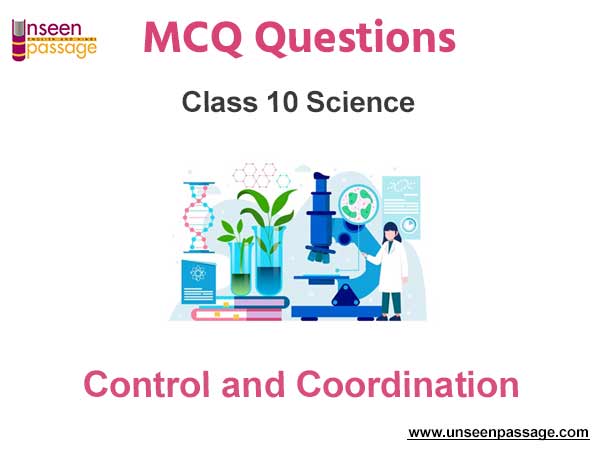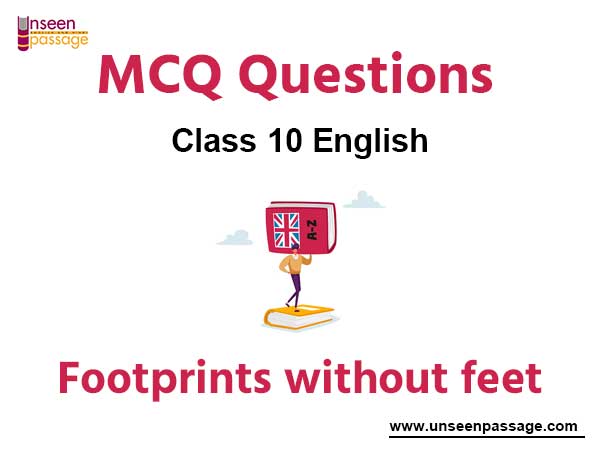Control and Coordination MCQ Class 10 Science
Please refer to Chapter 7 Control and Coordination MCQ Class 10 Science with answers below. These multiple-choice questions have been prepared based on the latest NCERT book for Class 10 Science. Students should refer to MCQ Questions for Class 10 Science with Answers to score more marks in Grade 10 Science exams. Students should read the chapter Control and Coordination and then attempt the following objective questions.
MCQ Questions Class 10 Science Chapter 7 Control and Coordination
The Control and Coordination MCQ Class 10 Science provided below covers all important topics given in this chapter. These MCQs will help you to properly prepare for exams.
Question. Which of the following acts as both endocrine and exocrine gland?
(a) Pancreas
(b) Thyroid
(c) Adrenal
(d) Liver
Answer
A
Question. Which nerves transmit impulses from the cen¬tral nervous system towards muscle cells?
(a) Sensory nerves
(b) Motor nerves
(c) Relay nerves
(d) Cranial nerves
Answer
B
Question. Which of the following is a plant hormone?
(a) Insulin
(b) Thyroxin
(c) Oestrogen
(d) Cytokinins
Answer
D
Question. Response of plant roots towards water is called:
(a) Chemotropism
(b) Phototropism
(c) Hydrotropism
(d) Geotropism
Answer
C
Question. Which of the following tissues provide control and coordination in animals?
(a) Nervous and Skeletal
(b) Muscular and Skeletal
(c) Muscular and Transport
(d) Nervous and Muscular
Answer
D
Question. Assertion: Plants do have a nervous system for control and coordination.
Reason: Plants use electro chemical means to convey information from cell to cell.
(a) Both A and R are true and R is the correct explanation of A.
(b) Both A and R are true but R is not the correct explanation of A.
(c) A is true but R is false.
(d) A is false but R is true.
(e) Both A and R are false.
Answer
D
Question. Which of the following is not a ductless gland?
(a) Adrenal
(b) Liver
(c) Thyroid
(d) Pituitary
Answer
B
Question. Junctions of two neurons in called.
(a) Synapse
(b) Synapsis
(c) Joint
(d) Junction
Answer
A
Question. When a person is suffering from severe cold, he or she cannot .
(a) Differentiate the taste of an apple form that of an ice – cream.
(b) Differentiate red light from green light.
(c) Differentiate a hot object form a cold object.
(d) Differentiate the smell of a perfume form that of an agarbatti
Answer
D
Question. Which endocrine gland is also known as ‘master gland’?
(a) Pancreas
(b) Adrenal
(c) Pituitary
(d) Hypothalamus
Answer
C
Question. Ageing in human beings is caused by disappearance of which of the following glands?
(a) Adrenal
(b) Pituitary
(c) Thyroid
(d) Thymus
Answer
D
Question. Fall of mature leaves and fruits from plants is triggered by which of the following substance?
(a) Auxin
(b) Cytokinin
(c) Gibberellin
(d) Abscisic acid
Answer
D
Question. Which statement is incorrect about auxins?
(a) They promote the growth of root
(b) They promote the growth of shoot
(c) They influence the formation of flower and ripening of fruit
(d) They inhibit the growth of root
Answer
A
Question. The hormone that is used to keep flowers fresh is
(a) cytokinin
(b) gibberellins
(c) auxin
(d) abscisic acid
Answer
A
Question. How many pairs of cranial nerves are present in man?
(a) 12
(b) 21
(c) 31
(d) 41
Answer
A
Question. A plant bends towards the source of light when exposed to the light on only one side. Which of the following is the best explanation of the phenomena ?
(a) It needs light for photosynthesis
(b) The apices of their stems are attracted by light
(c) Some auxin accumulates on the shaded side to induce greater cell elongation on that side
(d) Light stimulates the cells on the illuminated side to increase in length
Answer
C
Question. Gibberellic acid has been successfully employed to induce flowering
(a) in long day plants under short day conditions
(b) in short day plants under long day conditions
(c) for some plants
(d) none of the above
Answer
A
Question. Cytokinins are known to
(a) inhibit cytoplamic movement
(c) help in retention of chlorophyll
(c) influence water movement
(d) promote abscission layer formation
Answer
B
Question. Ethylene is a
(a) solid hormone
(b) gaseous enzyme
(c) gaseous hormone
(d) liquid gas mixture
Answer
C
Question. Pineapple an be made to flower if off season by
(a) zeatin
(b) ethylene
(c) temperature
(d) short days
Answer
B
Question. The effect of daily light period on flowering is called
(a) photooxidation
(b) phototropism
(c) photoperiodism
(d) photorespiration
Answer
C
Question. The sensation of sight in human brain is perceived by
(a) optic lobe
(b) occipital lobe
(c) frontal lobe
(d) parietal lobe
Answer
B
Question. If the tip of a seeding is cut off, growth as well as bending ceases because it hampers
(a) perception of light stimulus
(b) transpiration
(c) respiration
(d) photosynthesis.
Answer
A
Question. Brain stem is formed by the union of
(a) optic lobes
(b) cerebellum with optic lobes
(c) corpora striate
(d) mid brain, ponsvarolli and medulla oblongata
Answer
D
Question. Number of spinal nerves in man are
(a) 11 pairs
(b) 13 pairs
(c) 6 pairs
(d) 31 pairs
Answer
D
Question. Third ventricle occurs in
(a) cerebrum
(b) cerebellum
(c) medulla oblongata
(d) diencephalon
Answer
D
Question. Phytohormones are
(a) hormones regulating growth from seed to adulthood
(b) hormones regulating secondary growth
(c) growth regulators synthesized by plants and influencing physiological processes
(d) hormones regulating flowering.
Answer
C
Question. The movement of plant organs in response to the force of gravity is called
(a) hydrotropism
(b) geotropism
(c) heliotropism
(d) phototropism
Answer
B
Question. A high concentration of synthetic auxins is generally used for
(a) wee control
(b) enhancing root initiation
(c) controlling of cell enlargement
(d) preventing the growth of the lateral buds.
Answer
A
Question. The natural plant hormones were first isolated from
(a) cotton fruits, spinach leaves, rice plant
(b) avena coleoptiles, fungus gibberella
(c) corn germ oil, human urine
(d) human urine, rice plant.
Answer
B
Question. Part of brain involved in interpretation, storage of information and initiation of response on the basis of past experience is
(a) motor area
(b) cerebellum
(c) sensory area
(d) association area
Answer
D
Question. Autonomic nervous system controls
(a) reflex action
(b) sense organs
(c) internal organs
(d) skeletal muscle
Answer
C
Question. The study of nervous system and its disorders is called
(a) neurogenesis
(b) hematology
(c) neuroglia
(d) neurology
Answer
D
Question. In reflex action the reflex arc is formed by
(a) brain spinal cord muscles
(b) receptor spinal cord muscles
(c) muscle receptor brain
(d) muscles spinal cord receptor
Answer
B
Question. The pineal body is considered as
(a) an endocrine gland
(b) an organ concerned with voluntary actions
(c) an organ concerned with vision
(d) a vestige of third eye and endocrine gland
Answer
D
Question. Posture and balance of the body is controlled by
(a) Pons
(b) Medulla oblongata
(c) Cerebellum
(d) Cerebrum
Answer
C
Question. Select the mismatched pair
(a) Adrenaline – Pituitary gland
(b) Testosterone – Testes
(c) Estrogen – Ovary
(d) Thyroxin – Thyroid gland.
Answer
A
Question. Visceral nervous system controls and integrates the function of
(a) Urinary bladder
(b) Blood vessels
(c) Heart
(d) All of the above
Answer
D
Question. The neurons that carry nerve impulse from spinal cord to effectors are called:
(a) Sensory neurons
(b) motor neurons
(c) Inteneurons
(d) spinal neurons
Answer
B
Question. Assertion: Impulse travels from dendrite to cell body and then along the axon to its end.
Reason: Information acquired at the end of the dendrite tip of a nerve cell sets of an electric impulse.
(a) Both A and R are true and R is the correct explanation of A.
(b) Both A and R are true but R is not the correct explanation of A.
(c) A is true but R is false.
(d) A is false but R is true.
(e) Both A and R are false.
Answer
A
Question. Main function of cerebrum is
(a) thinking
(b) hearing
(c) memory
(d) balancing
Answer
A
Question. Identify which of the following statements about thyroxin is incorrect ?
(a) Thyroid gland requires iodine to synthesize thyroxin.
(b) Thyroxin is also called thyroid hormone.
(c) It regulates protein, carbohydrates and fat metabolism in the body.
(d) Iron is essential for the synthesis of thyroxin.
Answer
D

We hope you liked the above Control and Coordination MCQ Class 10 Science. In case you have any questions please put them in the comments box below and our teachers will provide you a response.


